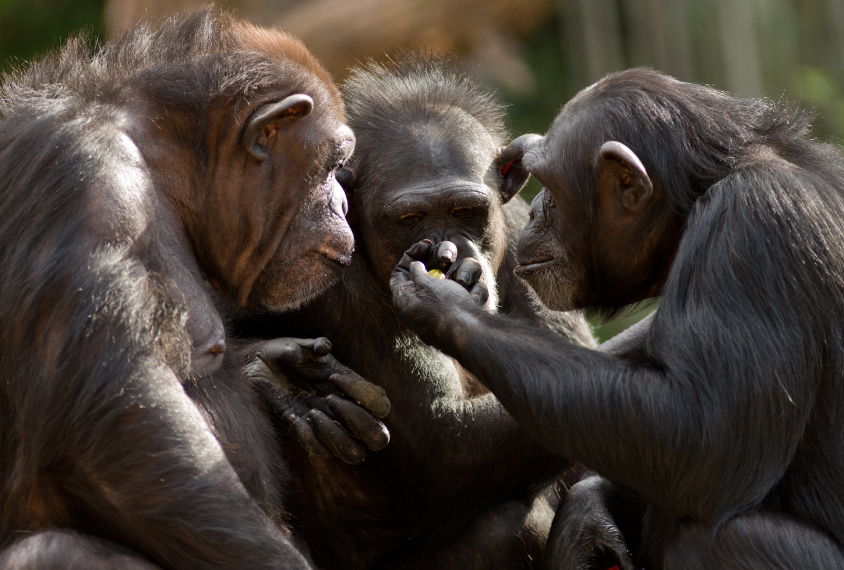
©iStock.com / curioustiger
THIS ARTICLE IS MORE THAN FIVE YEARS OLD
This article is more than five years old. Autism research — and science in general — is constantly evolving, so older articles may contain information or theories that have been reevaluated since their original publication date.


The billions of bacteria that reside in our guts play a key role in digestion and immune function. The power of these bacteria may extend beyond basic health to behavior, through connections between the gut and the brain. These bustling communities, known as the microbiome, may in fact be culprits in a range of conditions, including autism.
The ties between gut bacteria and behavior may tug in both directions. A number of studies over the past five years have suggested that some microbes can improve behavior. A team of primatologists at Gombe Stream National Park in Tanzania has now shown the reverse — that behavior influences the gut’s bacteria.
For almost a decade, these researchers have been detailing the everyday lives of chimpanzees, meticulously tracking their interactions and diet, scooping their poop and sequencing DNA from the microbes that colonize it.
The analyses, reported 15 January in Science Advances, reveal seasonal shifts in the size and diversity of the microbiome that track with swings in social behavior: The microbiome appears to be richer during rainy seasons when chimps forage together than during dry seasons when they forage alone1.
We asked researchers Andrew Moeller, research fellow at the University of California, Berkeley, and Howard Ochman, professor of integrative biology at the University of Texas at Austin, what these findings in chimps might mean for people in general, and for people with autism in particular.
Spectrum: How does a rich microbial community foster health?
Andrew Moeller: There are still a lot of open questions about what the bacteria in the gut are doing — which are good, which are bad, and under what conditions certain bacteria are good or bad. It’s not just a case of having more bacteria being better for you.
That said, studies have shown that people with certain types of inflammatory bowel disease or opportunistic infections in the gut such as Clostridium difficile harbor less diversity in their microbiomes. Now whether that’s a cause or effect of the disease is not clear. But it is known in insects and mice, for example, that the microbiota of the host protects against infection. If you experimentally remove the microbiota and create a germ-free organism, that organism will be very susceptible to opportunistic infections. So having the full complement of your healthy gut flora is probably protecting against some of these diseases.
S: How do social interactions fit into the picture?
Howard Ochman: We show that social interactions increase microbial diversity. So if you happen to lose some vital component of the microbiome, it can be restored through social interactions. But remember that social interactions can also transfer harmful bacteria, which is how infectious diseases are often spread. So there are tradeoffs to these behaviors.
AM: As we learn about the bacteria and microbes that are at least not harmful and maybe even beneficial, we are investigating the degree to which social interactions spread these microbes.
S: What did you find?
AM: We found marked changes in the chimps’ social activity from season to season. In dry seasons, chimpanzees tend to spend a lot of time alone, foraging. They travel far away from each other. In wet seasons, chimpanzees spend a lot of time in social groups, foraging together and interacting.
During the periods of high social activity, individual chimpanzees harbor more species of gut bacteria than they do during periods of low social activity. We also found that during periods of high social activity, chimpanzee microbiomes are more similar to one another than they are during periods of low social activity.
We used a very coarse metric for social activity — the average percentage of time chimpanzees spent together in social groups. We weren’t trying to tease apart behaviors such as grooming, incidental contact or sexual activity.
These findings point to a role for social activity in generating this thing that we’re calling the ‘pan microbiome.’ This is the microbiome of the social group that transcends the microbiome of any individual and helps to maintain bacterial species diversity over long periods of time.
S: What nonsocial factors influence the microbiome?
AM: Diet, immune function and all sorts of other things affect the microbiome. So, many factors are shaping how similar and dissimilar the chimpanzee microbiomes are.
S: Why do you study these effects in chimps instead of people?
AM: People value privacy. We don’t want someone around 24/7 detailing every social interaction we have and exactly what we’re eating. The degree of observational detail that’s possible to collect from a chimpanzee population is far beyond what you would get from people.
That’s an important point, because the patterns we’re detecting are pretty subtle, actually. I mean, there’s a lot of variation in our data that’s not explained by social contact. We see a significant effect, but it’s not so overwhelming that we would be able to detect it if our observations weren’t as meticulous as they are.
S: What do your findings mean for human social groups?
AM: There’s a need to understand how human social interactions are shaping our microbiomes. There’s some evidence that unrelated people who live in the same household share microbes. But do people from the same town share microbiomes? From the same state? Is there a microbial route that corresponds to routes of human travel? How are human populations across the world linked in terms of microbial exchange?
That’s basically an unknown right now. And it’s difficult to study in the context of pathogens, because pathogen transmission events are very rare. But if we can understand how commensal microbes are transferred across the world, we can get a sense of what transmission networks in human populations look like. This could be useful for predicting how pathogens might spread. It’s going to take lots of work to map the whole world in this way, but I think eventually this is going to be a big deal for public health to understand this worldwide microbial network.
S: How might autism researchers follow up on these findings?
AM: There’s evidence that people with autism have altered gut microbiota. But why they do, and what the mechanism is, is not totally clear. And so that’s one thing to look at. I’d be surprised if the lack of social interaction has a big effect on their microbiomes. It’s unlikely, but it isn’t impossible.
By joining the discussion, you agree to our privacy policy.